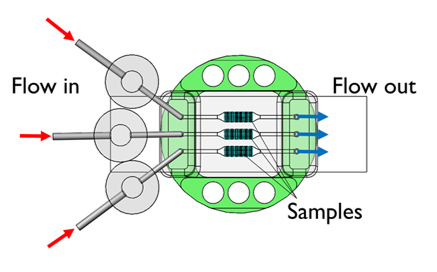MOAB: Miniaturised Optically Accessible perfusion Bioreactor
The MOAB is an innovative modular perfused bioreactor, developed to take over the limits of those available on the market.
Nowadays, the perfused bioreactors commonly used to provide models of tissue growth under controlled conditions in tissue engineering and pharmaceutical research, do not allow to perform undisruptive assays (with the exception of optical microscopy). “The MOAB is the evolution of such classical bioreactors” (Prof. Manuela Raimondi one of the inventors and Associate professor at the DEPARTMENT OF CHEMISTRY, MATERIALS AND CHEMICAL ENGINEERING “GIULIO NATTA”, DCMIC).
The MOAB core technology features are:
- to provide the best optical accessibility of the growing three-dimensional tissue (up to 40X), using a standard inverted fluorescence microscope: only optically transparent materials such as glass and transparent polystyrene are employed. Moreover, the thickness of the glass components (0.1 mm) and of the scaffold’s grid (0.4 mm) guarantee to increase imaging quality and to observe the multiple layers of the cell culture. This feature allow the users to perform multiple analyses during the entire culture period, without interrupting the cell culture.
- to culture up to three independent samples simultaneously: the bioreactor was designed to host three different chambers. Each chamber can be easily opened and closed independently several times, while maintaining the sterility of the culture. Each chamber can host a different culture model: scaffold cultures, hydrogels, monolayer cultures or pieces of explanted biological tissue, based on the desired experimental protocol. The chambers are perfused through three independent microfluidic channels, that can be connected either to a single syringe pump, in order to supply the same flow rate to the three chambers, or with different pumps. Moreover, the channels can be connected with a bypass allowing sequential culture pathways.
- to develop a user-friendly device: magnetic holders (which are not in contact with the cells) are designed to hermetically close the chambers and to be easily assembled by the users under sterile conditions. This innovative feature allows the bioreactor to face pressure and flow rate significantly higher than in the standard experimental conditions avoiding leakage. Moreover the magnetic holders are designed to fit with the microscope stage, improving the optical accessibility and the imagine quality.
“Thanks to all these features, the MOAB can be considered a 4D bioreactor (the 4th dimension is represented by time) for prolonged and multiple cell culture” (Prof. Raimondi).
The bioreactor has been extensively validated for cell culture using several cell types including human immortalized cell lines, mesenchymal stem cells and human neuron-like cells. The MOAB design is optimized for fabrication in series with low cost injection molding and assembly techniques; the device can be sterilized and commercialized for single- use tests, as a low cost and disposable device.
